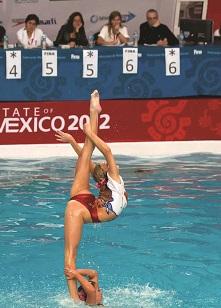

Julie Fabsik-Swarts: People at home don’t realize how physical a sport this is. This is not Esther Williams in an old-time flowered bathing suit and a matching cap twirling around in the water. It is fast, beautiful, athletic and powerful. We like to tell people, ‘If you think you’re ready to do it, let’s see you hold your breath for four minutes while you’re doing jumping jacks.’ It’s that demanding.”
SDM: Is the presence of a local synchronized swimming program or club important when you are selecting a site for competition?
Fabsik-Swarts: Yes, it is essential. There are about 5,500 USA Synchro members across the U.S., in 300 affiliated clubs. We reach out to those groups because some of them are very experienced in putting on events. A convention and visitors bureau can help us find the hotels and local attractions, and the synchro club can tell us about the facilities and put us in touch with the people who know the sport. Like many sports, synchronized swimming is passed down through families, so certain areas have a particular enthusiasm and passion for it.
SDM: Outside of family ties, how does USA Synchro grow its membership?
Fabsik-Swarts: Every year, during the month of May, we have nationwide promotion called USA Synchro de Mayo, and clubs will hold exhibitions and open houses and invite the public to try the sport. And of course, we always hope for the post-Olympic boost. We also work in conjunction with the U.S. Olympic Committee’s Olympics Day promotion.
Editor’s Note: Olympics Day is a promotion in June that in addition to promoting awareness of the Olympic Games, also celebrates the Olympic ideals of Perseverance, Respect and Sportsmanship. It can include demonstrations of one or more sports that are included in the Olympics, and is especially effective when an Olympic or Paralympic athlete is able to make an appearance. The general public is often invited to try participating in a specific sport that day as well, with no fee. Information about Olympics Day can be obtained from the USOC.
 SDM: What are some of the biggest challenges for USA Synchro?
SDM: What are some of the biggest challenges for USA Synchro?
Fabsik-Swarts: There are a lot of financial barriers. I’d really like to see us grow our sport and to do that, we need to support our athletes. Right now, our top athletes get only $500 a month. If it weren’t for the parents, they wouldn’t be able to do it. We don’t have the money to fund athletes as an incentive for them to stay in the sport for several Olympics. Our competitors such as Russia and China have athletes who have been competing together for a decade. In the past, our judges were all volunteers, and paid their own travel expenses for competitions; thanks to sponsorship this year, we were able to pay their way. They still have to put in many hours plus pay for their own education and updates, though. They are truly passionate lovers of our sport.
About USA Synchro: USA Synchro is based in Indianapolis and serves as the National Governing Body (NGB) for the sport of synchronized swimming which is featured in the summer Olympics. It is a membership-based and not-for-profit organization which services the sport from the grass roots level to the National Team. The mission statement of USA Synchro is "to provide leadership and resources for the promotion and growth of synchronized swimming, to achieve competitive excellence at all levels and to develop broad-based participation."

